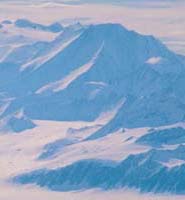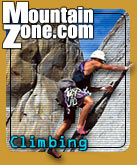Climbing In Antarctica
Putting Up A New Route On Vinson Massif

|
| Vinson Massif from about 50 miles out from the east. Photo: Robert M. Anderson |
Night - but the light of day follows us across the Nimitz Glacier. High clouds filter the midnight sun and snow and skies turn the same color of gray. Beyond my ski tips is the void and as vision fades, the snow begins to speak. Ski skins over snow squeak in the cold. They stop and click, metal against metal on the bindings. A left facing slope means a lower ski with a treble crunch, the uphill ski with a bass crunch. As sight fades, sound tells us what the mountains have to say.
In the distance, or close at hand, or not so far away, distance being indistinguishable, was a rising series of ice towers cut with crevasses. And when my skis told me we were starting up towards them and the sled tugged more insistently behind, I figured the glacier had been crossed and turned to glide back to a flat spot and set up camp.
The Camp Chorus:
- Probe the whole area to make sure there aren't any hidden crevasses lurking to swallow us up.
- Flatten the snow with the skis.
- Build snow walls with the shovel.
- Pitch the tent and heap snow around it.
- Pull the sleds and packs close so they tuck up against the tent like happy little piglets.
- Jump in the tent and light the stove.
- Get in the sleeping bag.
- Drink tea.
- Eat.
- Go to sleep.
Dead Sleds
Perhaps every footstep we take is over untouched ground - we have no record of anyone having passed this way before. Soon we know why, as the icefall steepens and the sleds take on a mind of their own, our 100 pounds of stuff slipping sideways on traverses and trying to run back down the hill. The sleds soon win the battle and we abandon them one by one on the steep slope, anchoring them to our ice hammers, leaving the slope littered with sled bodies. We carry the packs higher and dump them, returning for the sleds. Breeze is non-existent, sun ever present. It is Antarctica hot, a new phenomenon, eternal sun melting into the black long underwear. Sweat pours and is sucked into the dry air as our bodies steam dry. Where is the cold we were promised?
The Camp Chorus (repeat):
We leave behind the stereo (too heavy), half the food (for later) extra clothes (too warm) and set off in the fog from camp. I have hopes it will clear higher or later. It doesn't. We navigate by GPS using a supposed point where we would like to be. This gives us confidence but not accuracy because we really aren't sure where we need to go. When you go where no one has gone before it is nice to be able to see where you are going. Two hours later my skis start up a steeper hill. Snow and sky merge and looking back the team are only a misty apparition. The ice fog is clinging to us so closely the only option is to again do:
The Camp Chorus (but we are getting faster at it thank God because we seem to be doing a lot of it):
Sleep comes, the fog goes. We awake in Antarctic splendor, a cliché but an applicable cliché. Swish, swish go the skis.
Pump, pump goes the heart.
The South West Face is looming, 7,000 feet of vertical on a map and 7,000 vertical feet in reality are a long ways apart. We will now try and climb up for a mile and a half. People walk a mile, run a mile, now we tip the idea on it's end and go straight up for awhile. And a little bit sideways, just so we can hang on.
Robert Anderson, MountainZone.com Correspondent

